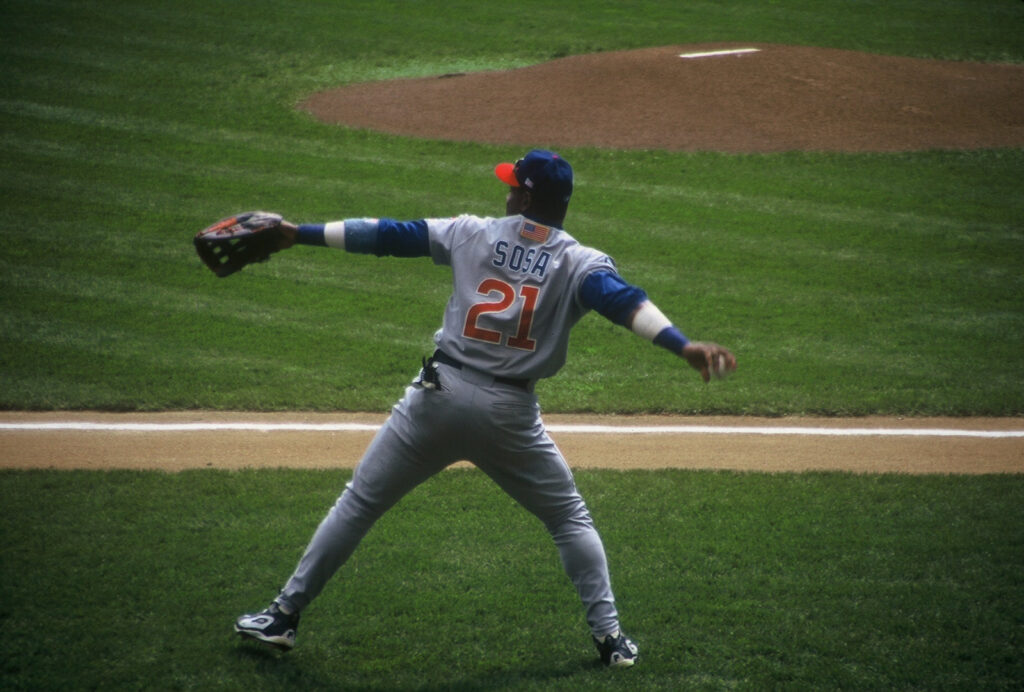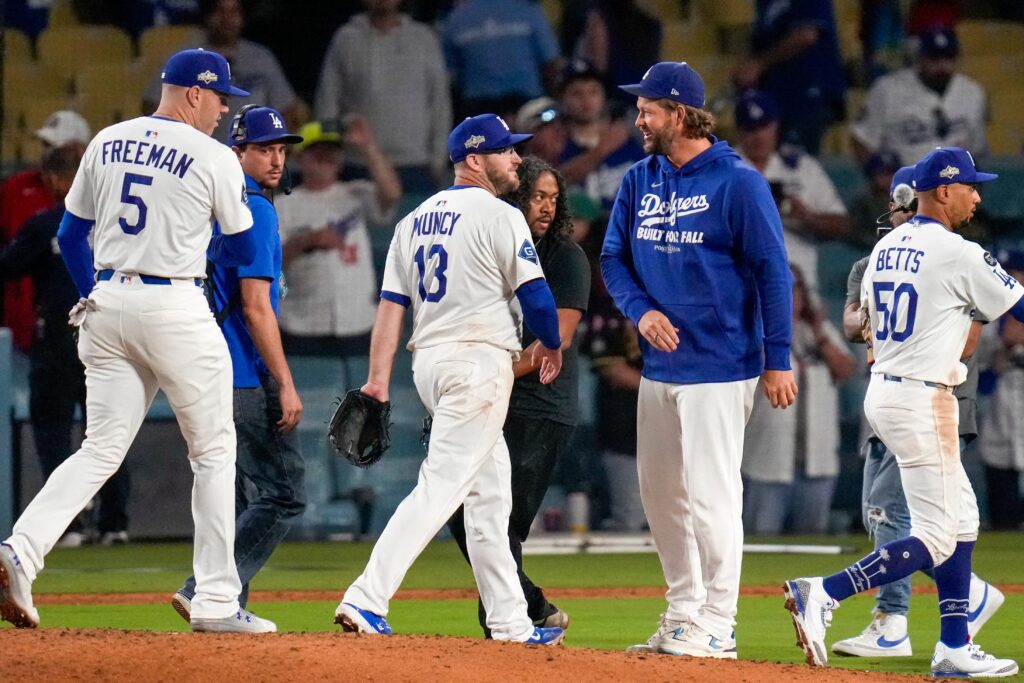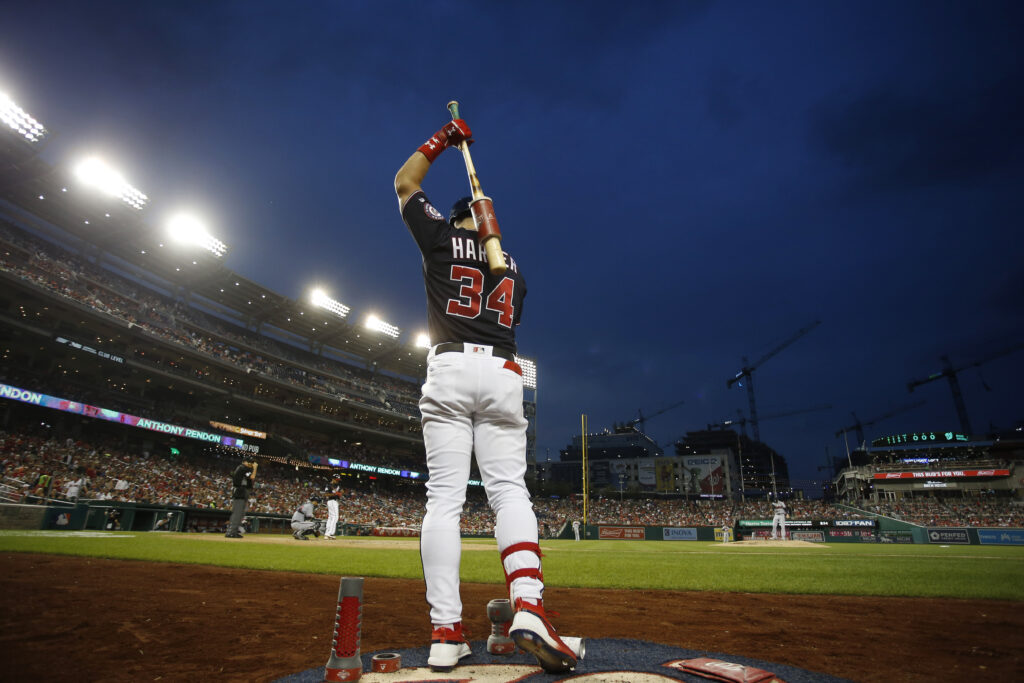This is the fourth article in a series that looks at the five best players at each position for the Chicago Cubs. In this installment are the outfielders.
If you are a fan of baseball history and the Chicago Cubs, this is the story to read. Although there is plenty of depth in terms of talent, the list of all-time best outfielders in Chicago Cubs history does not contain very many modern players. What it does have is six Hall of Famers, including the man who holds the Major League record for RBIs in a season.
The Best Outfielders in Chicago Cubs History
Left Fielders
Center Fielders
Honorable Mention – The center field has been a black hole for the Cubs in recent years. In fact, in the 73 seasons since 1950, the team has had 47 different players as primary starters. The one with the most productivity was Rick Monday, who patrolled the position in Wrigley Field from 1972-76. He was a steady hitter and a solid fielder whose best season with the Cubs was his last. In 1976, he posted career bests with 107 runs scored, 32 home runs, and 77 runs batted in, but it was a “defensive” play that made him a household name.
On April 25 against the Dodgers, a few would-be protesters decided to come onto the field at Dodger Stadium and light the American Flag on fire, but Monday ran in and scooped up the flag before that could happen. In 702 games with the Cubs, Monday hit .270 with 690 hits, 106 homers, and 293 RBIs.
5. Andy Pafko – He was a five-time All-Star during his nine seasons with Chicago (1943-51). Pafko’s best season was in 1948 when he posted career highs with a .322 average, 171 hits, and 30 doubles to go along with 26 home runs and 101 runs batted in. Other good seasons included 1945 (with a career-best 110 RBIs) and 1950 (career highs with 95 runs and 36 home runs). Overall, Pafko hit .294 with 1,084 hits, 126 homers, and 584 RBIs in 719 games. In the 1945 World Series, he scored five runs and drove in two more, but the Cubs lost in seven games to the Tigers.
4. George Gore – The run-scoring machine was a main piece on five pennant-winning teams during his eight-year tenure (1879-86). In 1880, Gore led the National League with a .360 average, and he topped the league in runs scored the following two years (86 in 1881 and 99 in 1882). However, his best season was 1886, when he drove in 63 runs and scored 150 despite only having 135 hits (he also led the league with 102 walks). Gore actually had more runs (772) than games played (719) with the White Stockings, and he also had 933 hits, 60 triples, 380 RBI, and a .315 average (with six seasons at .300 or better). In the National League vs. American Associated World Series contested in 1885-86, he had four hits and a home run.
3. Bill Lange – He was a converted second baseman who gave up his baseball career when he was in his prime. Lange was one of the first of what we now call a “five-tool player”. He was a career .330 hitter (a mark that ranks fifth in team history and includes a .389 average in 1895) who also had 691 runs, 1,056 hits, 80 triples, and 479 RBIs in 813 games. Lange also had five consecutive seasons with 80 or more RBIs and three straight in which he had at least 110 runs and 150 hits. However, his speed was his biggest asset. Lange ranks second in team history with 400 stolen bases, and his total includes six seasons with 60 or more, a team-record 84 in 1896, and a league-high 73 the following season.
Lange’s seven-year career came to an end after the 1899 season. The team was now called the Orphans after Cap Anson was let go as manager, and Lange lost his biggest supporter. He was traded to the Dodgers and was a holdout. He fell in love with the daughter of a wealthy insurance company owner, who refused to let her marry a ballplayer and gave Lange an ultimatum to leave baseball, which he did. The marriage lasted until 1915 and Lange became a coach and later a YMCA athletic director who was responsible for bringing sporting equipment to troops in Europe during World War I as well as looking for baseball talent on foreign soil.
2. Jimmy Ryan – He was a temperamental player who had a good eye at the plate and a strong arm in the outfield. Ryan had 100 or more hits in 14 of his 15 seasons with the White Stockings, and he hit over .300 in 10 seasons. His best campaign was in 1888, when he hit .325, had a career-high 60 steals, and led the league with 182 hits, 33 doubles, and 16 home runs. Ryan is the all-time franchise leader in triples (142), and he ranks second in runs (1,410), third in steals (370), eighth in hits (2,084) and doubles (362) and ninth in total bases (3,027) and runs batted in (914).
In the 1886 World Series, he had five hits and drove in two runs in a losing effort. Ryan had issues with reporters and had physical altercations with several. He also missed about half of the 1893 season after being involved in a serious train accident in which the sleeper car he and several other players were in flew off the tracks and crashed into a parked train on another track. Most of the other players were able to return to play fairly quickly but three other passengers died. After his playing career, Ryan was a bailiff and deputy sheriff in Illinois.
1. Hack Wilson – He could have been one of the all-time greats if not for his penchant for heavy drinking and bar brawling. Lewis Wilson was nicknamed “Hack” because his short and stocky build resembled George Hackenschmidt, a famous bodybuilder and champion wrestler in the early 1900s. The only person who Wilson seemed to listen to was Joe McCarthy, the Cubs manager and a future Hall of Famer. Under McCarthy’s watch, Wilson became one of the game’s best power hitters, leading the league in home runs four times and RBIs twice in his six seasons (1926-31).
His best year was in 1930 when he led the league with 105 walks, 56 home runs (a National League record that stood until 1998) and 191 runs batted in, a Major League record that still stands. In addition to homers and RBIs, Wilson also posted career bests that season with a .356 average, 146 runs, and 208 hits. Overall, he hit .322 (eighth-best in team history with five seasons at .300 or better), and he totaled 652 runs, 1,017 hits, 190 home runs, and 769 RBIs in 850 games.
McCarthy left to manage the Yankees in 1931 and Wilson’s production dropped dramatically. He was traded to the Dodgers and had a rebound year before falling off again once his alcoholism had taken its toll on his baseball skills. After his playing career, Wilson fell into obscurity. He gave an interview to the CBS radio show We, the People in 1948 where he warned about the effects of alcohol, and a little more than a week later, he died after a fall in his apartment. Wilson was inducted into the Baseball Hall of Fame by the Veteran’s Committee in 1979.
Right Fielders
Honorable Mention – Bill Nicholson was a five-time All-Star who hit 20 or more home runs six times in 10 seasons with the Cubs (1939-48). He led the National League with 29 home runs and 128 RBIs in 1943 and repeated the feat the following year with 33 homers and 122 runs batted in (along with a league-best and career-high 116 runs scored) while finishing a VERY close second in the National League MVP race. Overall, Nicholson had 738 runs, 1,323 hits, 295 home runs (ninth in team history), and 833 RBIs in 1,349 games. He also had eight RBIs in the seven-game loss to the Tigers in the 1985 World Series.
After two seasons in the short-lived Federal League, Max Flack joined the Cubs, where he spent the next seven seasons (1916-22). He started all six games in a loss to the Red Sox in the 1918 World Series, but his best season was in 1920 when he set career-highs with 85 runs, 157 hits, 49 RBIs, and a .302 average. Flack batted .277 with 833 hits, 209 runs batted in, and 108 stolen bases in 796 games with Chicago.
5. Kiki Cuyler – He showed flashes of talent with the Pirates, but he became a star after coming over to the Cubs in 1928. Hazen Cuyler earned his nickname from infielders repeatedly calling out “Cuy” when a fly ball was hit to him, and newspapers shortened it to Kiki (although still pronounced with a long I like his last name). Cuyler led the league in stolen bases his first three years in Chicago, and he also had a league-best 42 doubles in 1934 to help him earn his only All-Star selection (the game had just started the year before).
His best season was 1930 when he hit .330 with 13 home runs and career highs with 155 runs scored, 228 hits, and 134 runs batted in. In eight seasons (1928-35), Cuyler hit .325 (sixth-best in team history) with 665 runs, 1,199 hits, 79 home runs, 602 RBIs, and 161 stolen bases in 949 games. He played in two World Series with the Cubs, amassing 11 hits and six RBIs in nine games. Cuyler was inducted into the Baseball Hall of Fame by the Veteran’s Committee in 1968.
4. Frank Schulte – He was a solid performer for 13 seasons (1904-16), and he was also a key piece of four pennant-winning clubs. Schulte got his nickname due to his fandom for Lillian Russell, an actress on stage and screen at the time. The team saw her in a play called “Wildfire,” and visited with her at the after-party. Schulte owned horses, named one after her and eventually was given that nickname himself by the Chicago press.
He earned the MVP award in 1911 after hitting .300, leading the league with 21 home runs and 107 RBIs and also posting career highs with 105 runs, 173 hits, 30 doubles, 21 triples (tied for the single-season franchise record), and 23 stolen bases. Schulte had 827 runs, 1,590 hits, 254 doubles, and 117 triples (third in team history). 91 home runs, 713 RBIs, and 214 stolen bases in 1,564 games. He had 26 hits and nine RBIs in 21 World Series games and helped the Cubs win two titles.
3. Andre Dawson – He was known for his power and determination to overcome a dozen knee operations to forge a 21-year Major League career. Dawson only spent six seasons with the Cubs (1987-92), but he earned five All-Star selections, two gold gloves, and a silver slugger award during that time. In 1987, he did something that was unheard of at the time. He led the league with 49 home runs and 137 RBIs, added 90 runs and 178 hits, and won the MVP award with the last-place Cubs, the first time that had ever happened (Alex Rodriguez matched the feat with the 2003 Rangers). In his Chicago career, “Hawk” hit .285 with 929 hits, 174 home runs, and 587 RBIs in 867 games. He retired in 1996 and was elected to the Baseball Hall of Fame in 2010.
2. Mike “King” Kelly – He was a larger-than-life star who played baseball during the day and was a hard drinker and partier at night. During his seven-year run with the White Stockings (1880-86), Kelly led the league in runs scored three times and doubles and batting average twice each. His best season was 1886 when he led the league with a .388 average and 155 runs and set a career-high with 175 hits in just 118 games. Kelly totaled 728 runs, 899 hits, and 480 RBIs in just 681 games.
He was a member of five pennant-winning teams and had 14 hits and a home run in two early World Series appearances. However, Kelly’s best asset was his abilities as a baserunner. The National League only started keeping track of stolen bases in 1886, his ninth season and last with Chicago. However, he had 53 that year and 368 overall in his career.
Kelly was so popular that he held out for the highest salary and had a song written about him called “Slide Kelly, Slide”. However, his partying lifestyle was expensive and after his playing career ended, he went into vaudeville. Kelly caught pneumonia on a ship ride to a show in Boston and had trouble breathing. As he was being brought into the hospital, the stretcher he was on tipped, and Kelly was dumped to the floor, with him saying, “This is my last slide.” He died three days later. Kelly was inducted into the Baseball Hall of Fame in 1945.
1. Sammy Sosa – During his 13-year run with the Cubs (1992-2004), he put on an incredible power display. Sosa had five straight seasons with at least 100 runs scored, amassed 150 or more hits eight times, drove in at least 100 runs nine times, and hit 30 or more home runs in 11 seasons. The Home Run Chase in 1998 between Sosa and Mark McGwire was the most captivating in nearly 30 years and some people say its impact saved the sport after the 1994 lockout.
Sosa hit a Major League record 20 home runs in June and finished with a franchise-record 66 on the season. McGwire may have won the chase with 70, but Sosa was the MVP with a league-leading 135 runs and 158 RBIs along with career highs in home runs as well as hits (198). He is the only player in Major League history to hit 60 home runs in three seasons, but he didn’t lead the league any of those times (McGwire won 65-63 in 1999 and Sosa hit 64 in 2001 only to lose out to Barry Bonds, who hit a record 73). Sosa also led the league and set career highs with 143 runs and 160 RBIs.
Sosa was a seven-time All-Star and a six-time silver slugger who led the league in runs three times, and homers and RBIs twice each. He is the franchise record-holder with 545 home runs, and he ranks third in RBIs (1,414), fourth in total bases (3,980, including a team-record 425 in 2001), sixth in runs (1,245), ninth in hits (1,985) and tenth in games (1,811). However, his ties to the steroid controversy of the late 1990s and early 2000s may forever keep him out of the Hall of Fame. He maintains his innocence, but his highest vote total was 18.5 percent in his 10 years on the writer’s ballot, leaving his hands in the fate of the Today’s Game committee.
Chicago Cubs Catchers and Managers
Chicago Cubs First and Third Basemen
Chicago Cubs Second Basemen and Shortstops
Chicago Cubs Pitchers – coming soon
Previous Series
A look back at the Boston Red Sox
Boston Red Sox Catchers and Managers
Boston Red Sox First and Third Basemen
Boston Red Sox Second Basemen and Shortstops
Boston Red Sox Outfielders and Designated Hitters
Boston Red Sox Pitchers
A look back at the Baltimore Orioles
Baltimore Orioles Catchers and Managers
Baltimore Orioles First and Third Basemen
Baltimore Orioles Second Basemen and Shortstops
Baltimore Orioles Outfielders and Designated Hitters
Baltimore Orioles Pitchers
A look back at the Atlanta Braves
Catchers and Managers
First and Third Basemen
Second Basemen and Shortstops
Outfielders
Pitchers
A look back at the Arizona Diamondbacks
Catchers and Managers
First and Third Basemen
Second Basemen and Shortstops
Outfielders
Pitchers



